Incident Roles
Define responder roles and responsibilities for efficient incident management
Incident Roles allow you to customize a set of roles that you can assign during an incident. An established set of Incident Roles clearly defines incident responsibilities, promotes accountability, and enables efficient response.
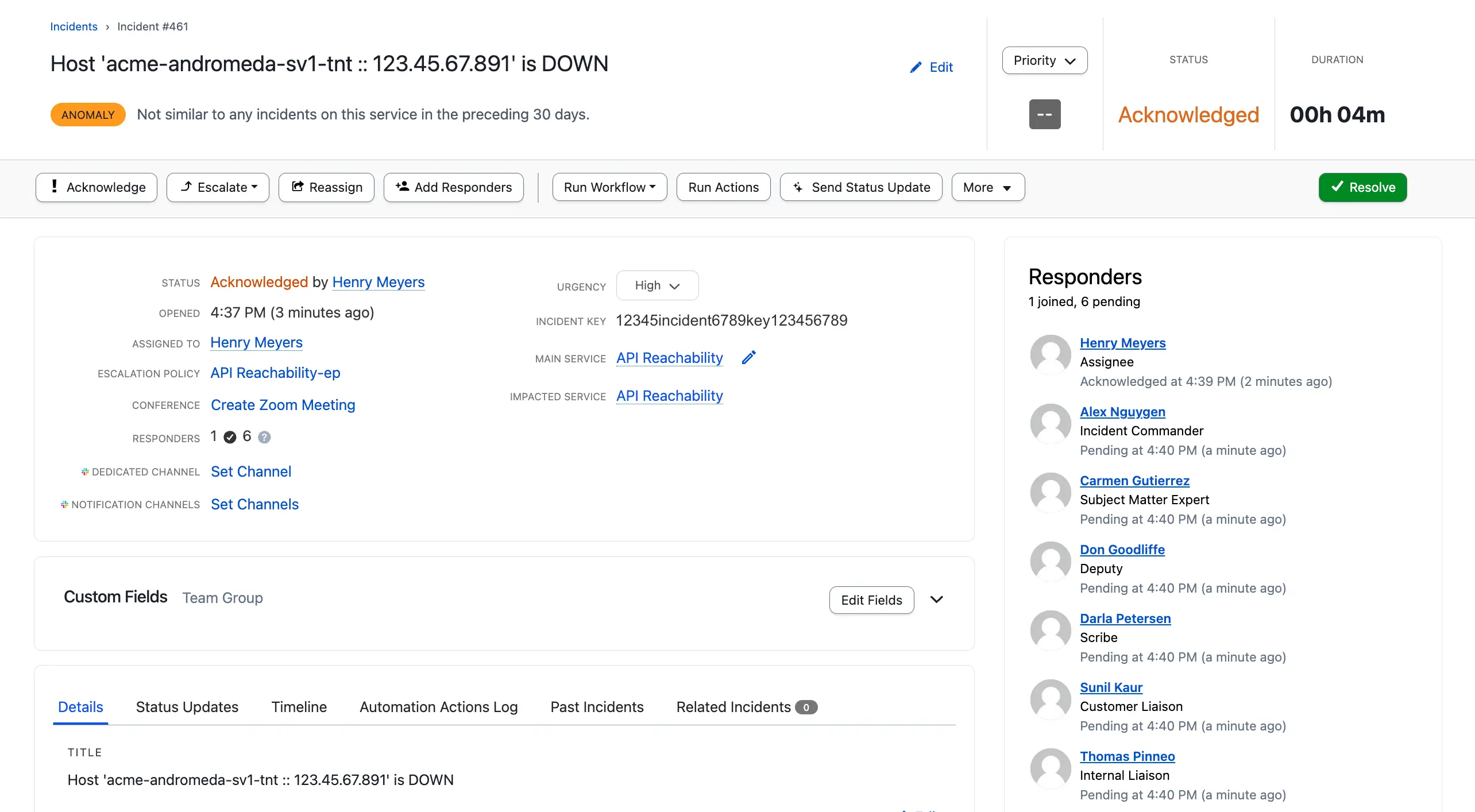
Incident Roles in Responders list
Availability
- Customers on the Enterprise plan for Incident Management can use two predefined roles (i.e., Incident Commander and Customer Liaison) and create up to 10 custom roles, for a total of 12 Incident Roles.
- Customers on the Business pricing plan can use two predefined roles (i.e., Incident Commander and Customer Liaison) and create one custom role.
- Customer on the Professional pricing plan can use two predefined roles (i.e., Incident Commander and Customer Liaison).
Professional Business Enterprise Predefined Roles (Incident Commander, Customer Liaison) ✔️ ✔️ ✔️ Custom Roles One 10 Please contact our Sales Team if you would like to upgrade or expand your Incident Roles feature set.
Incident Response Guide
For more information on how teams at PagerDuty use roles in our own incident management process, see our Incident Response Guide.
Default Incident Roles
There are two default Incident Roles:
- Incident Commander
- Customer Liaison
These roles will be in an enabled or disabled state based on your account plan. You may need to enable these roles in order to use them on incidents.

Create Incident Roles
Required User Permissions
Global Admins and the Account Owner can create, edit and delete account-wide Incident Roles.
-
Navigate to Incidents Incident Roles.
-
Click New Role and enter the following:
- Display Name: A role name to display on incidents.
- Role Name: A unique name for API use. This name can only contain lowercase letters, numbers, and underscores.
- Note: You cannot change the Role Name after role creation.
- Description: A description that will help responders understand the scope of the role and how they should use it.
- Disable Incident Role: Select Enable or Disable depending on your preference. If disabled, the role will no longer appear on incidents. Existing incident roles and assignees will remain unaffected.
-
Click Create Role.
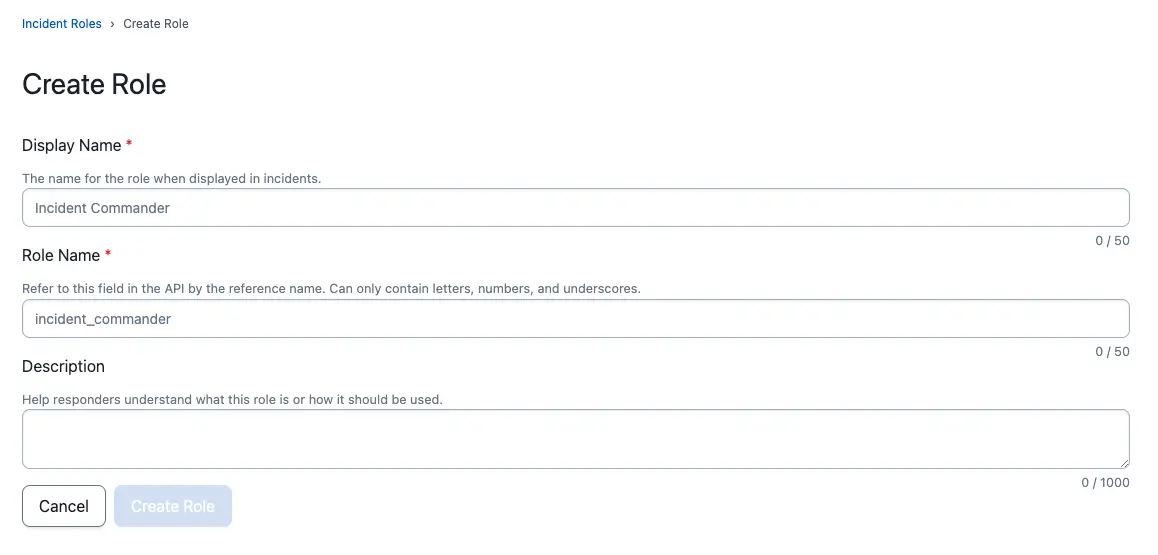
Edit Incident Roles
- Navigate to Incidents Incident Roles.
- On the right side of the role you wish to edit, click the overflow menu and select Edit Role.
- Display Name: Edit the role name that will display on incidents.
- Description: Edit the description that will help responders understand the scope of the role and how it should be used.
- Disable Incident Role: Select Enable or Disable depending on your preference. If disabled, the role will no longer appear on incidents. Existing incident roles and assignees will remain unaffected.
- Click Save Changes.
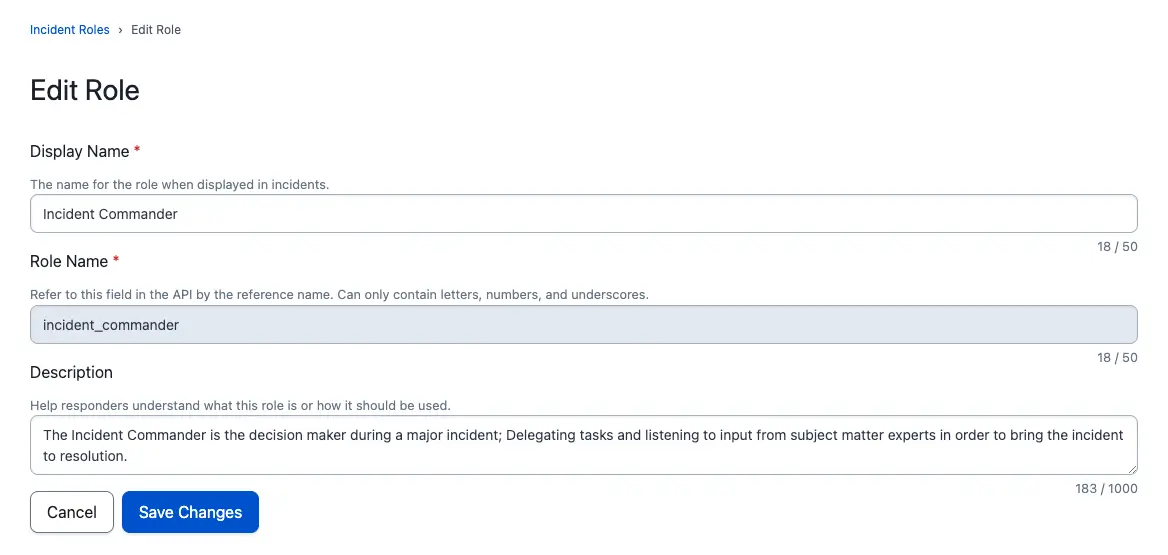
Enable or Disable Incident Roles
To enable or disable an existing Incident Role:
- Navigate to Incidents Incident Roles.
- On the right side of the role you wish to edit, click the overflow menu and select Edit Role.
- Disable Incident Role: Select Enable or Disable depending on your preference. If disabled, the role will no longer appear on incidents. Existing incident roles and assignees will remain unaffected.
- Click Save Changes.
Delete Incident Roles
Deletion Warning
We cannot recover an Incident Role once deleted.
- Navigate to Incidents Incident Roles.
- On the right side of the role you wish to delete, click the overflow menu and select Delete Role.
- A confirmation prompt will appear asking if you want to delete the role, as this action cannot be undone. Enter Delete in the text box and click Delete again to confirm deletion.
Assign an Incident Role
Once you've created an Incident Role, you can assign the role to an incident responder.
Behavior When you Assign Roles to Non-Responders
If you assign a role to a user who was not already a responder on the incident, this action will add them as a responder. The responder request will include the role assigned to the user.
Assign an Incident Role in the Web App
In the PagerDuty web app, you can assign incident roles to individual users or to escalation policies. When you assign a role to an escalation policy, it will send a responder invite to the on-call responder. Once accepted, PagerDuty will assign them to the role. If they do not accept the responder request before the escalation timeout, it will escalate to and notify the next level of the escalation policy.
Requirements
- A user who can take action on the incident (Responder permissions or higher) can assign Incident Roles in the web app.
- You cannot assign roles to Stakeholders.
- When viewing an incident, in the Responders list on the right, click Assign Roles.
- Select the dropdown for your preferred role to view the list of available responders.
- Select an Escalation Policy or User from their respective tabs to assign them to the corresponding Incident Role.
- Click Save.
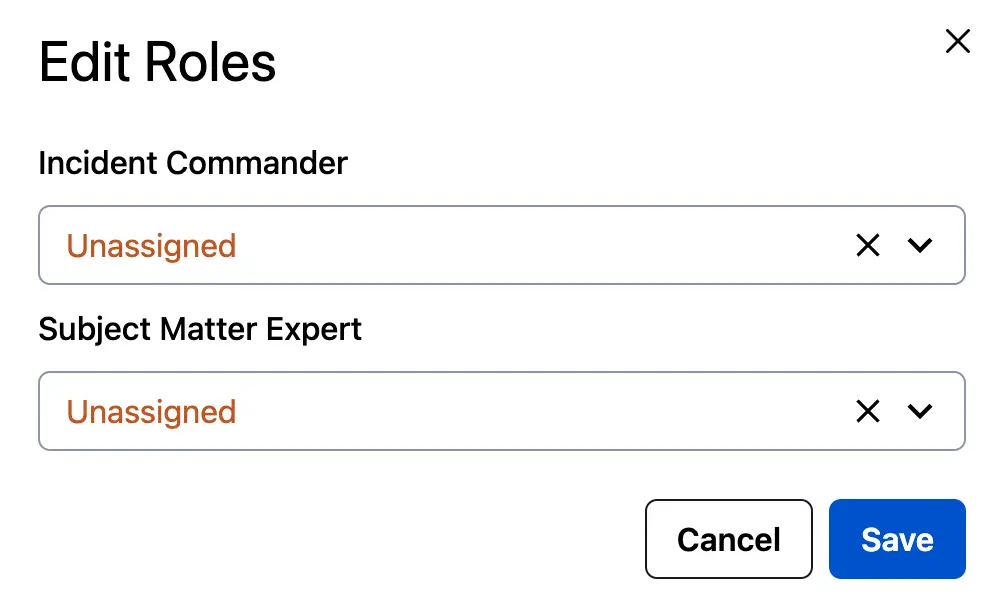
Assign or edit roles

Responder request with Incident Role
Assign an Incident Role in Slack
You can assign Incident Roles from a PagerDuty incident notification in Slack.
Requirements
- You must configure the Slack Integration in order to assign Incident Roles in Slack.
- You must have Responder permissions or higher to assign Incident Roles in Slack.
- In a Slack Workspace with a configured PagerDuty app, navigate to a PagerDuty incident notification.
- Click More Actions and select Assign Roles.
- Click the Select dropdown to view the list of available responders.
- Select a user to assign them to the corresponding Incident Role.
- Click Save.
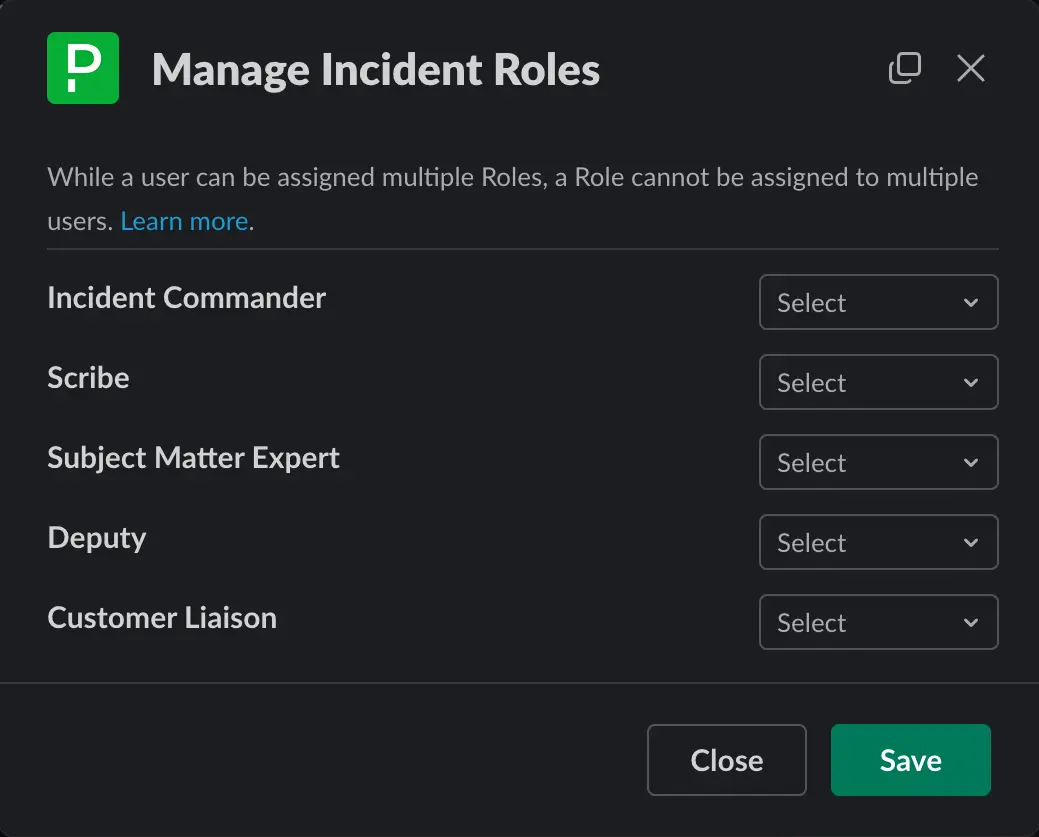
Assign an Incident Role in Microsoft Teams
You can assign an Incident Role from a PagerDuty incident notification in Microsoft Teams.
Requirements
- You must configure the Microsoft Teams Integration in order to assign Incident Roles in Teams.
- You must have Responder permissions or higher to assign Incident Roles in Teams.
- In a Microsoft Team chat with a configured PagerDuty app, navigate to a PagerDuty incident notification.
- Click the overflow menu and select Assign Roles.
- Click the Type to search for a user dropdown and begin typing to search for a user.
- Select a user to assign them to the corresponding Incident Role.
- Click Save.

Assign an Incident Role With Incident Workflows
After you’ve created incident roles, you can assign or unassign them as part of an Incident Workflow. This allows you to automate role assignments based on a set of workflow conditions, removing manual work from your Incident Management processes.
Learn more about assigning roles via Incident Workflows.
FAQ
Can I assign the same Incident Role to multiple responders?
No. You can only assign Incident Roles to a single responder at any given time. This promotes accountability during response by eliminating shared ownership.
Can I assign multiple roles to one user?
Yes, you can assign multiple roles to a single user.
Where are Incident Roles available in PagerDuty?
Incident roles are available in the web app, Slack, Microsoft Teams and Incident Workflows. There are plans to bring Incident Roles to other parts of our product, including the mobile app, in the future.
Updated 6 months ago
